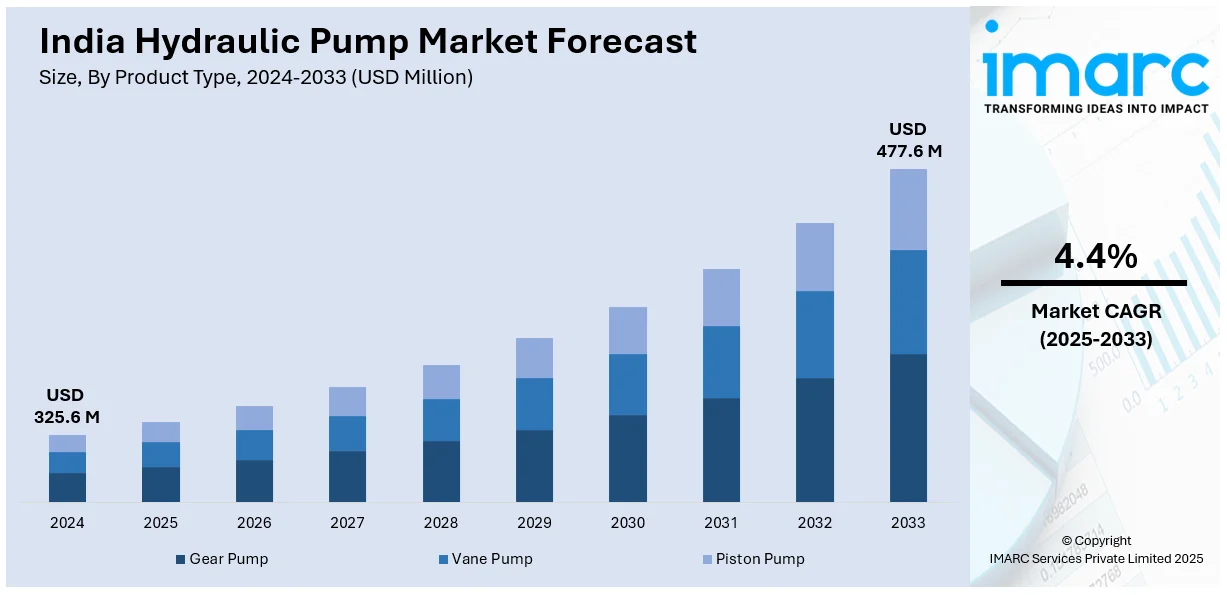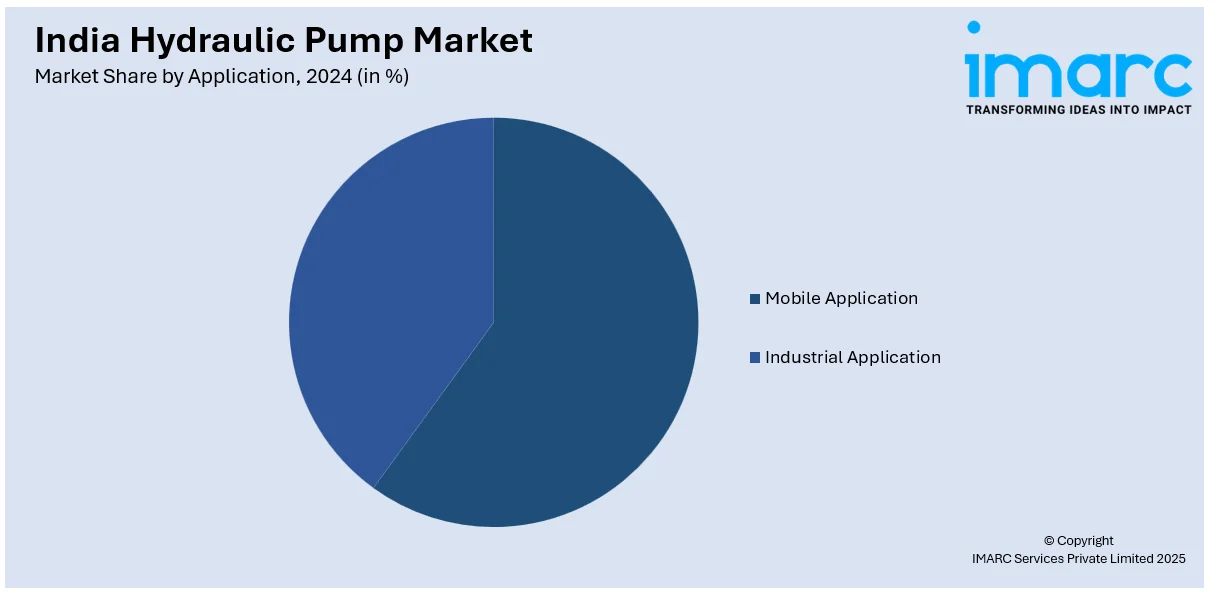
India Hydraulic Pump Market Size, Share, Trends and Forecast by Product Type, Pressure Range, Application, End User, and Region, 2025-2033
India Hydraulic Pump Market Overview:
The India hydraulic pump market size reached USD 325.6 Million in 2024. Looking forward, IMARC Group expects the market to reach USD 477.6 Million by 2033, exhibiting a growth rate (CAGR) of 4.4% during 2025-2033. The market is driven by increasing demand for energy-efficient solutions, government initiatives promoting sustainability, and the growing adoption of hydraulic systems in agriculture and construction. Infrastructure development projects, mechanization in farming, and advancements in IoT-enabled hydraulic technologies further propel India hydraulic pump market growth, creating opportunities for cost-effective and high-performance hydraulic pump solutions.
|
Report Attribute
|
Key Statistics
|
|---|---|
|
Base Year
|
2024 |
|
Forecast Years
|
2025-2033
|
|
Historical Years
|
2019-2024
|
| Market Size in 2024 | USD 325.6 Million |
| Market Forecast in 2033 | USD 477.6 Million |
| Market Growth Rate 2025-2033 | 4.4% |
India Hydraulic Pump Market Trends:
Increasing Demand for Energy-Efficient Hydraulic Pumps
The significant shift towards energy-efficient solutions, driven by rising energy costs and growing environmental concerns, is favoring the India hydraulic pump market share. Industries such as construction, agriculture, and manufacturing are increasingly adopting hydraulic pumps that consume less power while maintaining high performance. Government initiatives promoting sustainable practices and energy conservation are further fueling this trend. By December 2024, India's Swachh Bharat Mission-Grameen Phase II has shown a significant 460% increase in the total number of ODF Plus villages, amounting to 561,000. At the same time, it has also enabled 150 million rural tap water connections through the Jal Jeevan Mission. In this regard, these government initiatives play a crucial role in the adoption of sustainable water management, sanitation, and infrastructure, which is an essential component of the market. Further, industries are targeting the development of new generation hydraulic pumps with provisions for variable speed drives and smart controls to reduce energy consumption. On the other hand, incorporation of IoT and automation into hydraulic systems is also making real-time energy management and monitoring possible, promoting efficient working. The trend will further pick up pace as sectors become inclined to lower their carbon footprint as well as their operation expenses.

To get more information on this market, Request Sample
Rising Adoption of Hydraulic Pumps in Agriculture and Construction
The India hydraulic pump market outlook is experiencing robust growth due to the increasing adoption of hydraulic systems in the agriculture and construction sectors. According to a research report by IMARC Group, the Indian agritech market reached a value of USD 878.1 Million in 2024. The market is expected to reach USD 6,152.3 Million by 2033, growing at a 10.93% CAGR during the forecast period 2025-2033. In agriculture, hydraulic pumps are essential for modern machinery such as tractors, harvesters, and irrigation systems, which are becoming more prevalent as farmers embrace mechanization to improve productivity. Similarly, the construction industry is witnessing a rise in infrastructure projects, including roads, bridges, and urban development, thereby driving the demand for hydraulic pumps in equipment, including excavators, cranes, and loaders. The government’s focus on initiatives such as "Make in India" and investments in infrastructure development are further propelling this trend. Additionally, the availability of cost-effective and durable hydraulic pumps tailored to local requirements is enhancing their adoption. As these sectors continue to expand, the demand for hydraulic pumps is expected to grow significantly, creating lucrative opportunities for market players.
India Hydraulic Pump Market Segmentation:
IMARC Group provides an analysis of the key trends in each segment of the market, along with forecasts at the country level for 2025-2033. Our report has categorized the market based on product type, pressure range, application, and end user.
Product Type Insights:
- Gear Pump
- Vane Pump
- Piston Pump
The report has provided a detailed breakup and analysis of the market based on the product type. This includes gear pump, vane pump, and piston pump.
Pressure Range Insights:
- Up to 600 PSI
- 601 PSI–1000 PSI
- More than 1000 PSI
A detailed breakup and analysis of the market based on the pressure range have also been provided in the report. This includes up to 600 PSI, 601 PSI–1000 PSI, and more than 1000 PSI.
Application Insights:

- Mobile Application
- Industrial Application
The report has provided a detailed breakup and analysis of the market based on the application. This includes mobile application and industrial application.
End User Insights:
- Construction
- Mining
- Agriculture
- Machinery
- Oil and Gas
- Chemicals and Petrochemicals
- Automotive
A detailed breakup and analysis of the market based on the end user have also been provided in the report. This includes construction, mining, agriculture, machinery, oil and gas, chemicals and petrochemicals, and automotive.
Regional Insights:
- North India
- South India
- East India
- West India
The report has also provided a comprehensive analysis of all the major regional markets, which include North India, South India, East India, and West India.
Competitive Landscape:
The market research report has also provided a comprehensive analysis of the competitive landscape. Competitive analysis such as market structure, key player positioning, top winning strategies, competitive dashboard, and company evaluation quadrant has been covered in the report. Also, detailed profiles of all major companies have been provided.
India Hydraulic Pump Market News:
- December 11, 2024: Bobcat has launched the B900 Xtra CEV Stage V Backhoe Loader, a high-performance machine designed for construction and mining operations, at Bauma CONEXPO India 2024. Some of the Key features include a powerful 74 HP Ashok Leyland engine, an operating weight of 7990 kg, a variable displacement hydraulic pump, a 2-wheel drive system with synchro shuttle transmission, impressive loader and backhoe performance, and a design focused on comfort and safety with a standard enclosed cabin and ergonomic controls.
India Hydraulic Pump Market Report Coverage:
| Report Features | Details |
|---|---|
| Base Year of the Analysis | 2024 |
| Historical Period | 2019-2024 |
| Forecast Period | 2025-2033 |
| Units | Million USD |
| Scope of the Report |
Exploration of Historical Trends and Market Outlook, Industry Catalysts and Challenges, Segment-Wise Historical and Future Market Assessment:
|
| Product Types Covered | Gear Pump, Vane Pump, Piston Pump |
| Pressure Ranges Covered | Up to 600 PSI, 601 PSI–1000 PSI, More than 1000 PSI |
| Applications Covered | Mobile Application, Industrial Application |
| End Users Covered | Construction, Mining, Agriculture, Machinery, Oil and Gas, Chemicals and Petrochemicals, Automotive |
| Regions Covered | North India, South India, East India, West India |
| Customization Scope | 10% Free Customization |
| Post-Sale Analyst Support | 10-12 Weeks |
| Delivery Format | PDF and Excel through Email (We can also provide the editable version of the report in PPT/Word format on special request) |
Key Benefits for Stakeholders:
- IMARC’s industry report offers a comprehensive quantitative analysis of various market segments, historical and current market trends, market forecasts, and dynamics of the India hydraulic pump market from 2019-2033.
- The research report provides the latest information on the market drivers, challenges, and opportunities in the India hydraulic pump market.
- Porter's five forces analysis assist stakeholders in assessing the impact of new entrants, competitive rivalry, supplier power, buyer power, and the threat of substitution. It helps stakeholders to analyze the level of competition within the India hydraulic pump industry and its attractiveness.
- Competitive landscape allows stakeholders to understand their competitive environment and provides an insight into the current positions of key players in the market.
Key Questions Answered in This Report
The India hydraulic pump market was valued at USD 325.6 Million in 2024.
The hydraulic pump market in India is projected to exhibit a CAGR of 4.4% during 2025-2033, reaching a value of USD 477.6 Million by 2033.
The hydraulic pump market in India is driven by rapid urbanization and infrastructure projects, increased mechanization in agriculture, and rising industrial automation. Demand for energy-efficient and eco-friendly pump technologies, coupled with government initiatives like Smart Cities and Make in India, further boosts growth across construction, agriculture, mining, and manufacturing sectors.
Need more help?
- Speak to our experienced analysts for insights on the current market scenarios.
- Include additional segments and countries to customize the report as per your requirement.
- Gain an unparalleled competitive advantage in your domain by understanding how to utilize the report and positively impacting your operations and revenue.
- For further assistance, please connect with our analysts.
 Request Customization
Request Customization
 Speak to an Analyst
Speak to an Analyst
 Request Brochure
Request Brochure
 Inquire Before Buying
Inquire Before Buying




.webp)




.webp)












